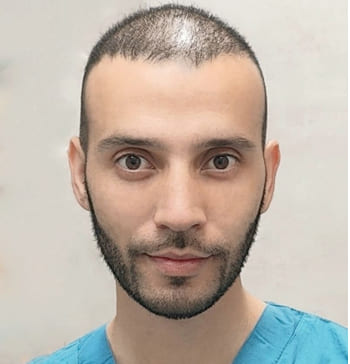
OCTAPLASMALG (AB) 45-70 MG/ML SOLUTION FOR INFUSION
Ask a doctor about a prescription for OCTAPLASMALG (AB) 45-70 MG/ML SOLUTION FOR INFUSION

How to use OCTAPLASMALG (AB) 45-70 MG/ML SOLUTION FOR INFUSION
Introduction
PACKAGE LEAFLET: INFORMATION FOR THE USER
OctaplasmaLG (A) 45-70 mg/ml solution for infusion
OctaplasmaLG (B) 45-70 mg/ml solution for infusion
OctaplasmaLG (AB) 45-70 mg/ml solution for infusion
OctaplasmaLG (0) 45-70 mg/ml solution for infusion
Human plasma proteins, with ABO blood group specificity
Read all of this leaflet carefully before you start using this medicine because it contains important information for you.
- Keep this leaflet, you may need to read it again.
- If you have any further questions, ask your doctor.
- This medicine has been prescribed for you only. Do not pass it on to others. It may harm them, even if their signs of illness are the same as yours.
- If you get any side effects, talk to your doctor. This includes any possible side effects not listed in this leaflet. See section 4.
Contents of the pack
- What is OctaplasmaLG and what is it used for
- What you need to know before you use OctaplasmaLG
- How to use OctaplasmaLG
- Possible side effects
5 Storage of OctaplasmaLG
- Contents of the pack and other information
1. What is OctaplasmaLG and what is it used for
OctaplasmaLG is a human plasma mixed and treated for viral inactivation. Human plasma is the liquid part of human blood in which cells are found. It contains important human plasma proteins for maintaining normal coagulation characteristics and is used in the same way as normal fresh frozen plasma (FFP).
OctaplasmaLG helps in cases of complex deficiencies of coagulation factors that may be caused by severe liver failure or massive transfusion. OctaplasmaLG can also be administered in emergency situations when a coagulation factor concentrate (such as factor V or factor XI) is not available or when laboratory diagnosis is not possible.
It can also be administered to rapidly reverse the effects of oral anticoagulants (such as coumarin or indandione), when vitamin K is insufficient due to altered liver function or in emergency situations.
OctaplasmaLG can be administered to patients undergoing plasma exchange to restore the balance of coagulation factors.
2. What you need to know before you use OctaplasmaLG
Do not use OctaplasmaLG:
- if you are allergic (hypersensitive) to human plasma proteins or to any of the other components of this medicine (listed in section 6).
- if you know you have antibodies against the immunoglobulin called IgA.
- if you have previously suffered reactions to human plasma preparations or FFP.
- if you know you have low protein S levels (a blood protein that depends on vitamin K).
Warnings and precautions
Consult your doctor before starting to use OctaplasmaLG.
Tell your doctor if you have any other illness.
Be careful with OctaplasmaLG
- if you have low IgA levels.
- if you have previously had reactions to plasma protein, including FFP.
- if you have heart failure or fluid in the lungs (pulmonary edema).
- if you know you have a risk of blood clotting complications (thrombotic) due to a possible increase in the risk of venous thromboembolism (clots that form in the veins).
- in case of increased blood coagulation inhibition (fibrinolysis).
OctaplasmaLG is not generally recommended for the treatment of von Willebrand disease.
Viral safety
When administering medicines prepared from human plasma or blood, certain measures are taken to prevent the transmission of infections to patients. This involves careful selection of blood and plasma donors to ensure the exclusion of those with a risk of infection, and analysis of each donation and plasma pools to detect signs of viruses or infections. Manufacturers of these products also include steps in the processing of blood or plasma that can inactivate or remove viruses. Despite these measures, when administering medicines prepared from human plasma or blood, it is not possible to completely exclude the possibility of transmission of infectious diseases. This also applies to any unknown or emerging virus, as well as other types of infections.
The measures taken are considered effective against enveloped viruses, such as human immunodeficiency virus (HIV), hepatitis B virus, and hepatitis C virus.
These measures may have limited value against certain non-enveloped viruses, such as hepatitis A virus, hepatitis E virus, and parvovirus B19.
It is strongly recommended that the name and batch number of the product be recorded each time a dose of OctaplasmaLG is administered in order to maintain a record of the batch used.
Your doctor may recommend that you be vaccinated against hepatitis A and B viruses if you regularly or repeatedly receive human plasma-derived products.
Children
Some cases of low calcium levels, possibly caused by citrate binding, have been observed during therapeutic plasma exchange in children. It is recommended to monitor calcium levels during this use of OctaplasmaLG.
Using OctaplasmaLG with other medicines
During clinical trials, OctaplasmaLG has been administered with several medicines and no interactions have been detected.
With the administration of OctaplasmaLG, you may receive substances (e.g. pregnancy hormone) that cause false-positive test results (e.g. positive pregnancy test without being pregnant).
OctaplasmaLG should not be mixed with other intravenous fluids or medicines except red blood cells and platelets.
To avoid the possibility of blood clots, solutions containing calcium should not be administered through the same intravenous line as OctaplasmaLG.
No interactions with other medicines are known.
Tell your doctor if you are using, have recently used, or might use any other medicine, including those obtained without a prescription.
Using OctaplasmaLG with food and drinks
No effects have been observed.
Pregnancy, breastfeeding, and fertility
If you are pregnant or breastfeeding, think you may be pregnant, or plan to become pregnant, consult your doctor before using this medicine. You will receive OctaplasmaLG if your doctor considers it necessary for you.
Driving and using machines
No effects on the ability to drive or use machines have been observed. You are the only one responsible for deciding whether you are fit to drive a vehicle or perform tasks that require much concentration.
Important information about some of the ingredients of OctaplasmaLG
To obtain a list of ingredients, see section 6.
This medicine contains a maximum of 920 mg of sodium (main component of table salt/cooking salt) in each bag. This is equivalent to a maximum of 46% of the recommended daily sodium intake for an adult.
3. How to use OctaplasmaLG
A doctor or nurse will administer OctaplasmaLG to you through an intravenous infusion.
Your dose will depend on your clinical condition and body weight. Your doctor will determine the appropriate amount you should receive.
- Before administering OctaplasmaLG through infusion, it is necessary to perform an ABO blood group compatibility test.
- In emergency cases, the AB blood group of OctaplasmaLG can be administered to all patients.
It is important that the infusion rate does not exceed 1 ml of OctaplasmaLG per kg of your body weight per minute. Calcium gluconate can be administered in another vein to minimize the negative effects of the citrate contained in OctaplasmaLG.
You should be under observation for at least 20 minutes after administration in case you develop an allergic reaction (anaphylactic reaction) or shock, in which case the infusion should be stopped immediately.
Use in children and adolescents
Data on use in children and adolescents (0-16 years) are limited.
If you use more OctaplasmaLG than you should
A high dose may cause fluid overload, fluid in the lungs, and/or heart problems.
If you forget to use OctaplasmaLG
Your doctor should supervise the administration and keep your laboratory values within the specified range.
If you stop using OctaplasmaLG
Based on laboratory values, your doctor will decide when to stop administering OctaplasmaLG and assess the potential risks.
Do not use after the expiry date stated on the label.
There are different options for thawing frozen OctaplasmaLG
- Water bath:
Thaw with the outer packaging in a water bath with good circulation for at least 30 minutes at a temperature between +30 and +37°C. If necessary, a bag can be used as a wrapper for added protection.
Avoid contaminating the entry port with water. The minimum thawing time is 30 minutes at 37°C. The bath temperature should never exceed +37°C and should not be below +30°C.
The thawing time will depend on the number of bags in the bath. If more bags are thawed in parallel, the time may be extended, but not more than 60 minutes.
- Using a dry warming system such as SAHARA-III:
Place the OctaplasmaLG bags in the agitation tray following the manufacturer's instructions and thaw the plasma with the rapid warming function. If the temperature display shows a temperature of +37°C, finish the warming process and remove the bags.
During the thawing of OctaplasmaLG using a dry warming system, it is recommended to use the protocol printer to keep a record of the temperature evolution of the blood product and error messages in case of failure.
- Others:
Other thawing systems can be used for frozen OctaplasmaLG provided they are validated for this purpose.
Allow the contents of the bag to warm to approximately +37°C before performing the infusion. The temperature of OctaplasmaLG should not exceed +37°C. Remove the outer packaging and check that the bag has no cracks or leaks.
Avoid shaking the bag.
After thawing, the resulting solution is clear or slightly opalescent and free of solid particles or gelatinous matter.
Do not use solutions that are cloudy or have sediment and/or discoloration.
Thawed OctaplasmaLG cannot be re-frozen. Unused product must be discarded.
The disposal of unused medicinal products and all materials that have come into contact with them will be carried out in accordance with local regulations.
4. Possible side effects
Like all medicines, this medicine can cause side effects, although not everybody gets them.
Rarely, hypersensitivity reactions may be observed. These are usually mild allergic reactions consisting of skin redness, hives, or itching. More severe forms can lead to complications such as decreased blood pressure or swelling of the face or tongue. Severe allergic reactions throughout the body could have a rapid onset and could be severe. Symptoms are: decreased blood pressure, increased heart rate, difficulty breathing, wheezing, coughing, shortness of breath, nausea, vomiting, diarrhea, abdominal or back pain. Severe reactions can lead to shock, loss of consciousness, respiratory failure, and very rarely even death.
The citrate contained in OctaplasmaLG can cause negative effects and be related to low calcium levels, especially if the infusion rate is high, if you have liver function disorders, or if you are undergoing plasma exchange procedures. You may experience symptoms such as: fatigue, tingling sensation (paresthesia), tremors, decreased calcium values.
OctaplasmaLG may increase the risk of blood clots in the veins of:
- limbs, causing pain and swelling of the limbs;
- lungs, causing chest pain and difficulty breathing;
- brain, causing weakness and/or loss of sensation on one side of the body;
- heart, causing chest pain;
In all patients with a risk of increased blood coagulation, special precautions should be taken and appropriate measures considered.
Rarely, incompatibility between OctaplasmaLG antibodies and blood antigens can cause destruction of your red blood cells (hemolytic transfusion reactions). Symptoms are: chills; fever; irritating cough; difficulty breathing; skin rash, and internal bleeding.
The infusion of OctaplasmaLG may increase certain antibodies of the coagulation factors.
A high dose or infusion rate may cause an increase in blood volume; fluid in the lungs, and/or heart failure.
Acute respiratory difficulties have been reported during or after the infusion of OctaplasmaLG.
During clinical trials with the predecessor product of OctaplasmaLG and its post-authorization use, the following side effects have been identified:
System organ class | Frequent(≥ 1/100 to< 1/10) | Uncommon(≥ 1/1,000 to< 1/100) | Rare(≥ 1/10,000 to< 1/1,000) | Very rare(< 1/10,000) | Not known§ |
Blood and lymphatic system disorders | Red blood cell loss Bleeding tendency | ||||
Immune system disorders | Hypersensitivity | Severe allergic reaction and shock | |||
Psychiatric disorders | Anxiety Agitation Restlessness | ||||
Nervous system disorders | Reduced sense of touch or sensitivity | Dizziness Tingling sensation | |||
Cardiac disorders | Heart failure Irregular heartbeats Increased heart rate | ||||
Vascular disorders | Blood clots in blood vessels Decreased blood pressure Increased blood pressure Circulatory failure Redness of the skin | ||||
Respiratory disorders | Lack of oxygen | Respiratory failure Pulmonary bleeding Constriction of the bronchi Fluid in the lungs Shortness of breath Difficulty breathing | Acute respiratory problems | ||
Gastrointestinal disorders | Vomiting Nausea | Abdominal pain | |||
Skin disorders | Hives Itching | Rash Increased sweating | |||
Musculoskeletal disorders | Back pain | ||||
General disorders and administration site conditions | Fever | Chest pain Chest discomfort Chills Localized edema General discomfort Reaction at the injection site | |||
Investigations | Positive antibody tests Decreased oxygen in the blood | ||||
Injury, poisoning, and procedural complications | Increased blood volume Citrate intoxication Red blood cell destruction |
§Spontaneous reporting data
Depending on the type and severity of the adverse reactions, the infusion rate should be reduced or the infusion stopped. Your doctor will take the necessary measures.
Tell your doctor or pharmacist if you think any of the side effects you are experiencing are serious or if you notice any side effects not listed in this leaflet.
Pediatric population
During plasma exchange procedures, low calcium levels may be observed in children, especially in patients with liver function disorders or at high infusion rates. It is recommended to monitor calcium levels during this use of OctaplasmaLG.
Reporting of side effects
If you experience any side effects, talk to your doctor, even if it is possible side effects not listed in this leaflet. You can also report them directly through the Spanish Pharmacovigilance System for Human Use Medicines: www.notificaRAM.es.
By reporting side effects, you can help provide more information on the safety of this medicine.
5. Storage of OctaplasmaLG
Keep this medicine out of the sight and reach of children.
Do not use this medicine after the expiry date which is stated on the label.
Store and transport frozen (at ≤ -18°C).
Store in the original packaging to protect from light.
After thawing, the physical and chemical stability in use has been demonstrated for 5 days between +2 and +8 °C or up to 8 hours at room temperature (between +20 and +25 °C).
From a microbiological point of view, unless the opening method prevents the risk of microbial contamination, the product should be used immediately. If it is not to be used immediately, the storage times and conditions will be the responsibility of the user.
Do not use this medicine if you notice that the solution is cloudy or contains sediment and/or discoloration.
Medicines should not be disposed of via wastewater or household waste. Ask your pharmacist how to dispose of the packaging and medicines that are no longer needed. This will help protect the environment.
6. Package Contents and Additional Information
Composition of OctaplasmaLG
- The active substance is human plasma proteins with ABO blood group specificity. A 200 ml bag contains: 9-14 g (45 - 70 mg/ml).
- The other components are:
Sodium citrate dihydrate, sodium dihydrogen phosphate dihydrate, and glycine.
Appearance and Package Contents of the Product
OctaplasmaLG is presented as a solution for infusion.
Blood bags of 200 ml.
Package size 1 or 10 bags.
The frozen solution is (slightly) yellow.
Marketing Authorization Holder:
Octapharma S.A.
Avda. Castilla, 2. (P.E. San Fernando)
Ed. Dublín, 2ª Planta
28830 San Fernando de Henares, Madrid
Manufacturer:
Octapharma AB
SE-112 75 Stockholm, Sweden
Date of the Last Revision of this Leaflet: 11/2024
Detailed information on this medicine is available on the website of the Spanish Agency for Medicines and Health Products (AEMPS)
http://www.aemps.gob.es/
--------------------------------------------------------------------------------------------------------------
This information is intended exclusively for healthcare professionals:
Dosage and Administration
Dosage
The dose depends on the clinical situation and the underlying disorder, but the initial dose is usually between 12 and 15 ml of OctaplasmaLG/kg of body weight. This dose should increase the patient's plasma coagulation factor levels by approximately 25%.
It is essential to monitor the response, both clinically and by performing measurements, for example, of the activated partial thromboplastin time (APTT), prothrombin time (PT), and/or specific coagulation factor assays.
Dosage for coagulation factor deficiencies:
Adequate hemostatic effect in minor and moderate bleeding or in interventions in patients with coagulation factor disorders is usually achieved after infusion of between 5 and 20 ml of OctaplasmaLG/kg of body weight. This dose should increase the patient's plasma coagulation factor levels by approximately 10-33%. In the case of major bleeding or surgical intervention, consultation with a hematologist is required.
Dosage for Thrombotic Thrombocytopenic Purpura (TTP) and bleeding in intensive plasma exchange:
For therapeutic plasma exchange procedures, expert advice from a hematologist should be sought.
In TTP patients, the total volume of plasma exchanged should be replaced with OctaplasmaLG.
Method of Administration
The administration of OctaplasmaLG should be performed specifically for the blood group. In emergency cases, the AB blood group of OctaplasmaLG can be considered as universal plasma, as it can be administered to all patients regardless of their blood group.
After thawing, OctaplasmaLG should be administered by intravenous infusion using an infusion set with filters. An aseptic technique should be used during infusion.
Citrate toxicity may occur if more than 0.02-0.025 mmol of citrate per kg and minute are administered. Therefore, the infusion rate of OctaplasmaLG should not exceed 1 ml per kg and minute.
The toxic effects of citrate can be minimized by administering calcium gluconate intravenously in another vein.
Warnings and Precautions for Administration:
Infusion should be stopped immediately in case of anaphylactic reaction or shock. Treatment should follow the guidelines for treating shock.
Patients should be observed for at least 20 minutes after administration.
Incompatibilities:
- OctaplasmaLG can be mixed with red blood cells and platelets if ABO compatibility is respected in both preparations.
- OctaplasmaLG should not be mixed with other medicines, as inactivation and precipitation may occur.
- To avoid the possibility of clot formation, solutions containing calcium should not be administered through the same intravenous line as OctaplasmaLG.
- Interference with serological tests
- Passive transmission of OctaplasmaLG plasma components (e.g., human chorionic gonadotropin β; β-hCG) may cause false laboratory results in the recipient. For example, false positives in pregnancy test results have been reported due to the passive transmission of β-hCG.
- Country of registration
- Prescription requiredYes
- Manufacturer
- This information is for reference only and does not constitute medical advice. Always consult a licensed doctor before taking any medication. Oladoctor is not responsible for medical decisions based on this content.
- Alternatives to OCTAPLASMALG (AB) 45-70 MG/ML SOLUTION FOR INFUSIONDosage form: INJECTABLE PERFUSION, 200 g/lActive substance: albuminManufacturer: Biotest Pharma GmbhPrescription requiredDosage form: INJECTABLE PERFUSION, 200 g/lActive substance: albuminManufacturer: Csl Behring GmbhPrescription requiredDosage form: INJECTABLE PERFUSION, 200 g/lActive substance: albuminManufacturer: Octapharma S.A.Prescription required
Alternatives to OCTAPLASMALG (AB) 45-70 MG/ML SOLUTION FOR INFUSION in other countries
The best alternatives with the same active ingredient and therapeutic effect.
Alternative to OCTAPLASMALG (AB) 45-70 MG/ML SOLUTION FOR INFUSION in Poland
Alternative to OCTAPLASMALG (AB) 45-70 MG/ML SOLUTION FOR INFUSION in Ukraine
Online doctors for OCTAPLASMALG (AB) 45-70 MG/ML SOLUTION FOR INFUSION
Discuss dosage, side effects, interactions, contraindications, and prescription renewal for OCTAPLASMALG (AB) 45-70 MG/ML SOLUTION FOR INFUSION – subject to medical assessment and local rules.














